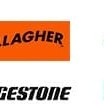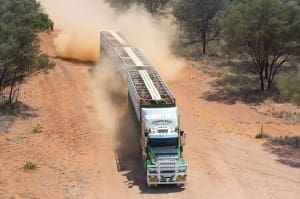WELCOME to Beef Central’s Top 25 Livestock Transporters feature, the first in a sequence of similar industry profiles to be published over the next 12 months.
This report profiles one of the most important, and often overlooked links in the complex Australian meat and livestock supply chain.
To Beef Central’s knowledge, no such national list has ever been compiled before. Research for this report has been exhaustive, touching every state, territory and region over the past two months, in an attempt to make this list as comprehensive, consistent and reliable as possible.
Presented here is the most comprehensive summary ever prepared on the nation’s livestock transport industry, and its largest players. The feature includes:
- A detailed table (click here to view, or access via Beef Central’s home-page navigation bar, or Top 25 icon appearing at top right of home page), listing the largest transporters by one-time uplift capacity, prime mover numbers and trailer numbers. A separate listing if ‘Top threes’ for each state and territory also appears within the feature.
- Profiles on each of the Top 25 entrants (click here to access) – how their businesses started, what ‘makes them tick’ today, a summary of their equipment and their contact details;
- A series of articles on the big issues facing the Australian livestock transport industry;
- As a handy future reference and contacts resource, the Top 25 feature articles and the entry list will remain permanently displayed on the Beef Central website.
In many ways, livestock transporters represent the lifeblood of the Australian meat and livestock supply chain, providing that vital linkage between breeding paddock, backgrounding property, saleyard, feedlot and meat processor or live export port.
$490 million total fleet value
In combination our inaugural Top 25 members operate a total of 614 prime movers and 1368 trailers, used in road-train, B-double, B-triple and single configurations.
At an average replacement cost per prime mover of $375,000, and trailer/dolly of $190,000, it values our total Top 25 fleet at close to half a billion dollars. A typical six-deck roadtrain configuration set up for heavy-duty work today costs about $900,000 to put on the road, before registration.
Suffice to say that our Top 25 feature will contains a number of big surprises as it unfolds in coming days.
Here are some of our key observations about the entries and industry trends, which will be explored in greater detail:
- All bar two of our Top 25 are what we could describe as ‘family owned’ businesses. Nine of the 25 entries could be described as multi-generational family businesses, started by the present owners’ fathers, grandfathers or uncles.
- The nature and client-base of operations vary enormously. Several 25 entries service just one customer, such as a large processor. Others have few, if any close alignments with large customers, servicing hundreds, if not thousands of customers over a 12-month cycle.
- Entries in our Top 25 come from every mainland Australian state plus Tasmania and the Northern Territory.
- While some entries have changed little in size over the past decade, others have exhibited explosive growth – some doubling and tripling in size in the past three or four years.
- Average haulage distance for each load also varies enormously. One entry, Tanami Transport based in Alice Springs, has average haul distances of 1600km. Another Victorian operator spoken to during research had average haulage distances of only 200km or less. The day Beef Central’s research team spoke to him, he had one rig that had three local jobs scheduled for the day.
- While most of the Top 25 are clearly seen is being ‘based’ in one part of Australia, in reality they are doing business across an incredibly wide footprint of the continent. A fleet truck based out of Alice Springs could easily be delivering cattle to Broome, or Naracoorte. Another based out of Wagga could easily drop a load off at an abattoir in southeast Queensland, before picking up another load at Roma for a run back to the Riverina.
- There appears to be a ‘sweet spot’ in terms of enterprise scale which provides business advantages for larger operators. Somewhere around six or seven units provides opportunity to spread fixed costs further, establish better-equipped maintenance facilities, while also allowing the business to compete for pastoral company-scale work, where larger uplifts are required.
- A series of industry structural changes appear to have have provided catalysts for either establishment of trucking businesses, or a turning-point in moving from being a smaller operation into something larger. Those catalysts appear to have included:
-
The major expansion in lotfeeding operations across Australia during the early 2000s
-
The momentum in live export growth up to 1997, and again during the late 2000s
-
The establishment of Federal Government funded beef roads in the NT in the early 1960s, and subsequent expansion of a more significant northern processing industry based on Katherine, Darwin, Wyndham and other locations
-
Consolidation of smaller regional processors into fewer, but larger processing entities.
-
The run-down in rail livestock freight services, most recently experienced in Queensland. Where once rail-heads like Quilpie operated daily 36-deck Cattle Train services, that is now back to once-a-week services in most centres.
One of the issues to emerge during our research was how different companies seek to overcome the challenge of ‘running home empty’ after a stock delivery. Return leg paid-freight is seen as one of the big challenges in efficiency and productivity faced by the livestock transport sector.
A range of solutions are evident in trying to manage this. For larger companies, networking and building client bases in different regions appears to be a key. Some companies in different geographic locations work cooperatively, especially during seasonal lows. Others use their websites (www.boylestransport.com.au is a good example) to post upcoming jobs, in an effort to find ‘complementary’ trucking business coming back the other way.
We at Beef Central hope you enjoy this important industry feature as it unfolds over the next fortnight.
For future reference purposes, the feature articles and the Top 25 list will remain prominently displayed on the website.
See this morning’s separate articles on Top 25 listings 11-13, click here.


